聊聊怎麼解析Apache Avro資料(範例講解)

隨著網際網路高速的發展,雲端計算、巨量資料、人工智慧AI、物聯網等前沿技術已然成為當今時代主流的高新技術,諸如電商網站、臉部辨識、無人駕駛、智慧家居、智慧城市等等,不僅方面方便了人們的衣食住行,背後更是時時刻刻有大量的資料在經過各種各樣的系統平臺的採集、清晰、分析,而保證資料的低時延、高吞吐、安全性就顯得尤為重要,Apache Avro本身通過Schema的方式序列化後進行二進位制傳輸,一方面保證了資料的高速傳輸,另一方面保證了資料安全性,avro當前在各個行業的應用越來越廣泛,如何對avro資料進行處理解析應用就格外重要,本文將演示如果序列化生成avro資料,並使用FlinkSQL進行解析。
本文是avro解析的demo,當前FlinkSQL僅適用於簡單的avro資料解析,複雜巢狀avro資料暫時不支援。
場景介紹
本文主要介紹以下三個重點內容:
如何序列化生成Avro資料
如何反序列化解析Avro資料
如何使用FlinkSQL解析Avro資料
前提條件
瞭解avro是什麼,可參考apache avro官網快速入門指南
瞭解avro應用場景
操作步驟
1、新建avro maven工程專案,設定pom依賴
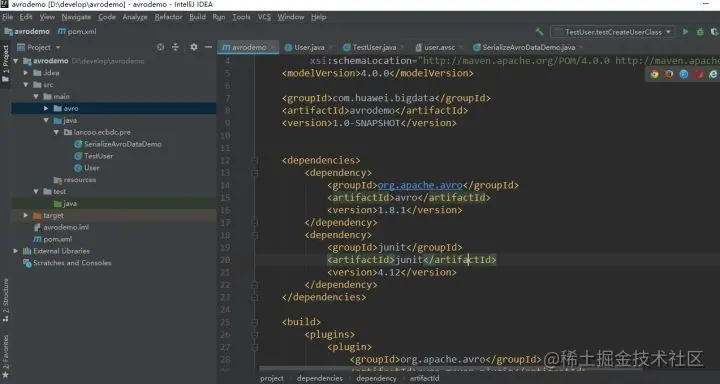
pom檔案內容如下:
<?xml version="1.0" encoding="UTF-8"?>
<project xmlns="http://maven.apache.org/POM/4.0.0"
xmlns:xsi="http://www.w3.org/2001/XMLSchema-instance"
xsi:schemaLocation="http://maven.apache.org/POM/4.0.0 http://maven.apache.org/xsd/maven-4.0.0.xsd">
<modelVersion>4.0.0</modelVersion>
<groupId>com.huawei.bigdata</groupId>
<artifactId>avrodemo</artifactId>
<version>1.0-SNAPSHOT</version>
<dependencies>
<dependency>
<groupId>org.apache.avro</groupId>
<artifactId>avro</artifactId>
<version>1.8.1</version>
</dependency>
<dependency>
<groupId>junit</groupId>
<artifactId>junit</artifactId>
<version>4.12</version>
</dependency>
</dependencies>
<build>
<plugins>
<plugin>
<groupId>org.apache.avro</groupId>
<artifactId>avro-maven-plugin</artifactId>
<version>1.8.1</version>
<executions>
<execution>
<phase>generate-sources</phase>
<goals>
<goal>schema</goal>
</goals>
<configuration>
<sourceDirectory>${project.basedir}/src/main/avro/</sourceDirectory>
<outputDirectory>${project.basedir}/src/main/java/</outputDirectory>
</configuration>
</execution>
</executions>
</plugin>
<plugin>
<groupId>org.apache.maven.plugins</groupId>
<artifactId>maven-compiler-plugin</artifactId>
<configuration>
<source>1.6</source>
<target>1.6</target>
</configuration>
</plugin>
</plugins>
</build>
</project>注意:以上pom檔案設定了自動生成類的路徑,即{project.basedir}/src/main/java/,這樣設定之後,在執行mvn命令的時候,這個外掛就會自動將此目錄下的avsc schema生成類檔案,並放到後者這個目錄下。如果沒有生成avro目錄,手動建立一下即可。
2、定義schema
使用JSON為Avro定義schema。schema由基本型別(null,boolean, int, long, float, double, bytes 和string)和複雜型別(record, enum, array, map, union, 和fixed)組成。例如,以下定義一個user的schema,在main目錄下建立一個avro目錄,然後在avro目錄下新建檔案 user.avsc :
{"namespace": "lancoo.ecbdc.pre",
"type": "record",
"name": "User",
"fields": [
{"name": "name", "type": "string"},
{"name": "favorite_number", "type": ["int", "null"]},
{"name": "favorite_color", "type": ["string", "null"]}
]
}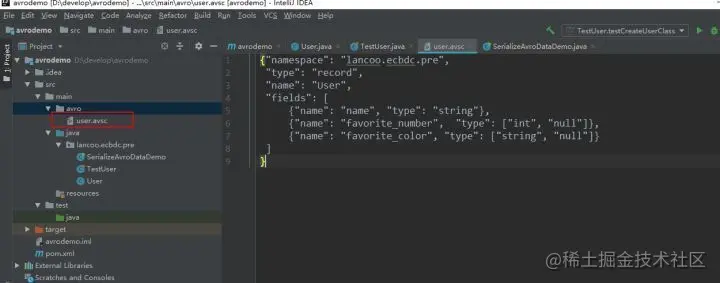
3、編譯schema
點選maven projects專案的compile進行編譯,會自動在建立namespace路徑和User類程式碼
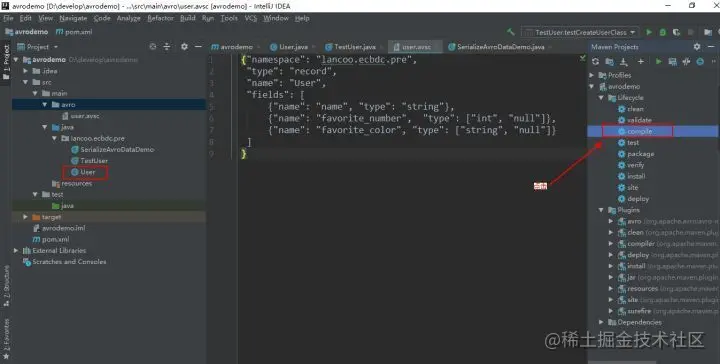
4、序列化
建立TestUser類,用於序列化生成資料
User user1 = new User();
user1.setName("Alyssa");
user1.setFavoriteNumber(256);
// Leave favorite col or null
// Alternate constructor
User user2 = new User("Ben", 7, "red");
// Construct via builder
User user3 = User.newBuilder()
.setName("Charlie")
.setFavoriteColor("blue")
.setFavoriteNumber(null)
.build();
// Serialize user1, user2 and user3 to disk
DatumWriter<User> userDatumWriter = new SpecificDatumWriter<User>(User.class);
DataFileWriter<User> dataFileWriter = new DataFileWriter<User>(userDatumWriter);
dataFileWriter.create(user1.getSchema(), new File("user_generic.avro"));
dataFileWriter.append(user1);
dataFileWriter.append(user2);
dataFileWriter.append(user3);
dataFileWriter.close();執行序列化程式後,會在專案的同級目錄下生成avro資料
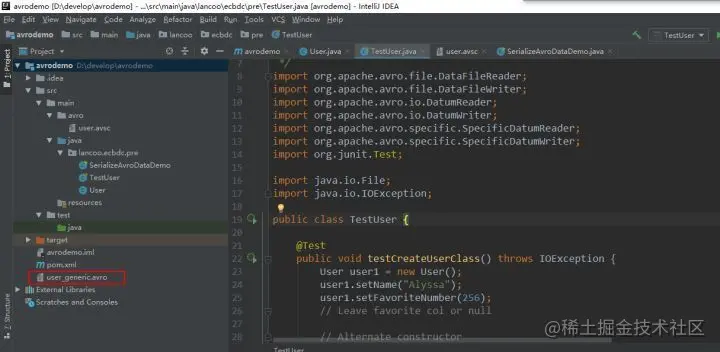
user_generic.avro內容如下:
Objavro.schema�{"type":"record","name":"User","namespace":"lancoo.ecbdc.pre","fields":[{"name":"name","type":"string"},{"name":"favorite_number","type":["int","null"]},{"name":"favorite_color","type":["string","null"]}]}至此avro資料已經生成。
5、反序列化
通過反序列化程式碼解析avro資料
// Deserialize Users from disk
DatumReader<User> userDatumReader = new SpecificDatumReader<User>(User.class);
DataFileReader<User> dataFileReader = new DataFileReader<User>(new File("user_generic.avro"), userDatumReader);
User user = null;
while (dataFileReader.hasNext()) {
// Reuse user object by passing it to next(). This saves us from
// allocating and garbage collecting many objects for files with
// many items.
user = dataFileReader.next(user);
System.out.println(user);
}執行反序列化程式碼解析user_generic.avro
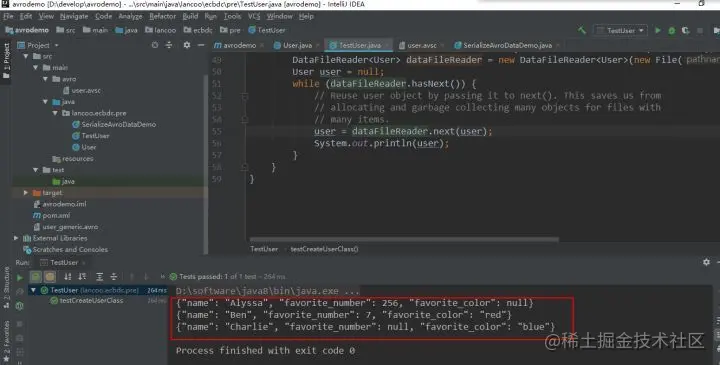
avro資料解析成功。
6、將user_generic.avro上傳至hdfs路徑
hdfs dfs -mkdir -p /tmp/lztest/ hdfs dfs -put user_generic.avro /tmp/lztest/

7、設定flinkserver
- 準備avro jar包
將flink-sql-avro-*.jar、flink-sql-avro-confluent-registry-*.jar放入flinkserver lib,將下面的命令在所有flinkserver節點執行
cp /opt/huawei/Bigdata/FusionInsight_Flink_8.1.2/install/FusionInsight-Flink-1.12.2/flink/opt/flink-sql-avro*.jar /opt/huawei/Bigdata/FusionInsight_Flink_8.1.3/install/FusionInsight-Flink-1.12.2/flink/lib chmod 500 flink-sql-avro*.jar chown omm:wheel flink-sql-avro*.jar
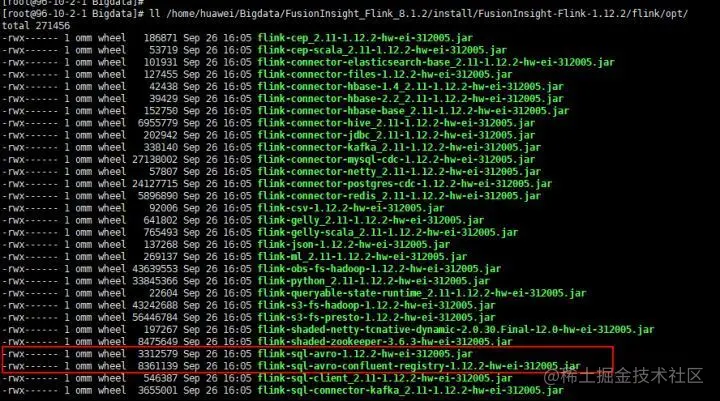
同時重新啟動FlinkServer範例,重新啟動完成後檢視avro包是否被上傳
hdfs dfs -ls /FusionInsight_FlinkServer/8.1.2-312005/lib

8、編寫FlinkSQL
CREATE TABLE testHdfs( name String, favorite_number int, favorite_color String ) WITH( 'connector' = 'filesystem', 'path' = 'hdfs:///tmp/lztest/user_generic.avro', 'format' = 'avro' );CREATE TABLE KafkaTable ( name String, favorite_number int, favorite_color String ) WITH ( 'connector' = 'kafka', 'topic' = 'testavro', 'properties.bootstrap.servers' = '96.10.2.1:21005', 'properties.group.id' = 'testGroup', 'scan.startup.mode' = 'latest-offset', 'format' = 'avro' ); insert into KafkaTable select * from testHdfs;

儲存提交任務
9、檢視對應topic中是否有資料

FlinkSQL解析avro資料成功。
【推薦:】
以上就是聊聊怎麼解析Apache Avro資料(範例講解)的詳細內容,更多請關注TW511.COM其它相關文章!